A framework for analyzing biopharmaceutical product introduction in an emerging market
Author(s)
Hong, Hong Tuyet
DownloadFull printable version (20.41Mb)
Other Contributors
Leaders for Manufacturing Program.
Advisor
Charles L. Cooney and Sara L. Breckman.
Terms of use
Metadata
Show full item recordAbstract
Biopharmaceutical companies are under constant pressure to deliver double-digit growth. In traditional markets such as the U.S., Japan, and the European Union growth is stagnant, and profit margins are falling due to increased price pressure from governments. As a result companies are looking to expand their customer bases. They see such opportunities in the emerging markets of China, India, and Eastern Europe where growth rates are in the double-digits. However, there are risks and uncertainties associated with expansion into emerging markets. These countries lack the regulatory systems and contract-enforcing mechanisms that most companies are used to operating under. In addition, pricing pressure from patients, governments, and healthcare organizations increases attention to the cost of goods. This document develops a framework for analyzing the potential for introducing a pharmaceutical product into a predetermined emerging market. The framework includes three steps. The first step is market assessment. The second step focuses on the supply chain. Information from market research is used to propose and evaluate alternative operational structures, to reduce costs, and to facilitate market entry. (cont.) The third step involves financial modeling using Monte Carlo Simulation to account for uncertainty in the information collected from the market assessment and supply chain analysis. The framework is applied in a case study which involves the Genzyme Corporation and evaluates the Chinese market for its cholesterol lowering drug, Cholestagel.
Description
Thesis (M.B.A.)--Massachusetts Institute of Technology, Sloan School of Management; and, (S.M.)--Massachusetts Institute of Technology, Dept. of Chemical Engineering; in conjunction with the Leaders for Manufacturing Program at MIT, 2006. Includes bibliographical references (leaf 45).
Date issued
2006Department
Leaders for Manufacturing Program at MIT; Massachusetts Institute of Technology. Department of Chemical Engineering; Sloan School of ManagementPublisher
Massachusetts Institute of Technology
Keywords
Sloan School of Management., Chemical Engineering., Leaders for Manufacturing Program.